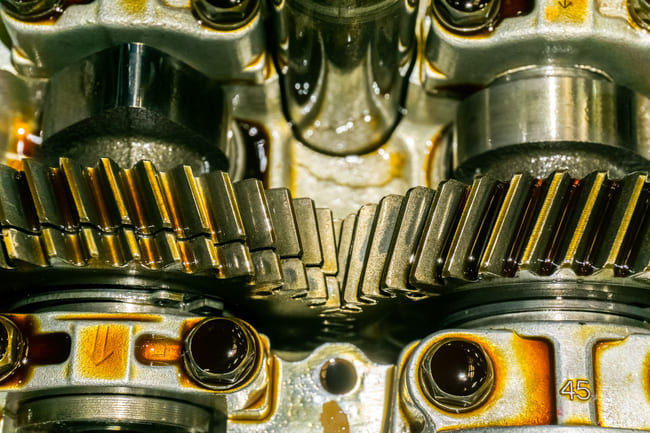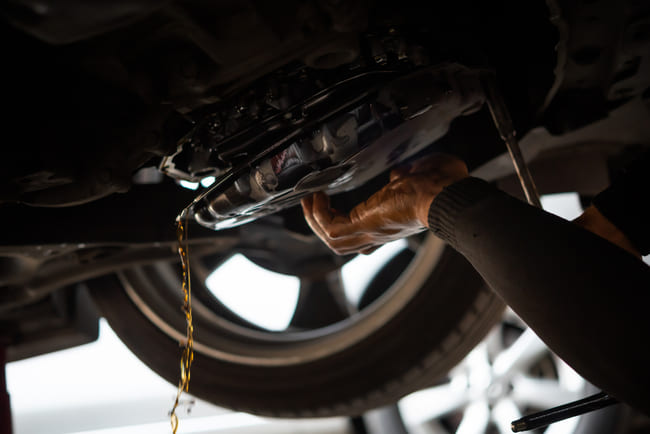Manual gearbox oil vs automatic transmission fluid
You might be thinking “same difference”, but there are crucial differences between these two types of oil. Using the wrong type of oil for a manual or automatic gearbox can lead to excessive wear and tear. This will ultimately cause the transmission to fail.
Manual gear oil
In manual transmissions, the oil is used to lubricate the moving parts when shifting gears, creating a protective barrier against wear and overheating. It tends to be much thicker than automatic transmission fluid and often has an intense smell due to the use of sulphur compounds in oil formulas. These products often use extreme pressure (EP) and anti-wear additives for increased protection in heavy duty applications. Some additives are corrosive to yellow metals, such as brass and copper. It is therefore important to make sure that the lubricant is compatible with your car gear system parts.
Automatic transmission fluid (ATF)
ATF is a tad more complex as it not only functions as a lubricant but is also used to transfer the hydraulic pressure required for the transmission to function, as well as to convert torque in power steering systems. ATF products contain anti-wear additives and antioxidants which also prevent corrosion. They tend to have a low viscosity, allowing them to flow better under certain operating conditions and reducing resistance.
You can usually differentiate between manual and automatic gearbox oil by looking at the colour of the fluid. ATF contains a dye which makes it look red or green. This makes it easier to detect transmission leaks. Manual gear oil, on the other hand, is normally a darker brown or amber colour.
How often should gear oil be changed?
As a general rule, experts recommend changing manual gear oil every 30,000 to 50,000 miles. Many modern cars have an oil life monitoring system which indicates when it’s time for a gearbox oil change. However, it is a good idea to inspect the fluid and oil levels yourself at regular intervals. You can do so using the transmission dipstick (if your vehicle has one). If the oil is very dark or sludgy, it has probably gone bad. If you’re running low on gear oil, you may have trouble shifting gears or feel the car shudder or shake. This can cause the transmission to overheat, as well as serious damage to the gears.

When to change transmission oil
The interval for changing automatic gearbox oil is typically between 30,000 and 60,000 miles. If the car regularly transports heavy loads, this interval may be shorter. Over time, the fluid will start to break down and can become contaminated with metal particles, water and debris. Healthy ATF should be almost transparent and have a sweet smell. If it smells burnt, the transmission is burning too hot and it is time for the system to be flushed and the fluid to be changed. Signs of low transmission oil include chattering or roaring sounds, an illuminated warning light, delays when shifting gears, and slipping gears.
How much does a gear oil change cost?
In the UK, you can generally expect to pay anywhere from £70 to £120 for a gear oil change, and roughly £150 to £200 to flush and refill an automatic transmission system. The prices will depend on the specific requirements of the vehicle and the quality of the fluid and parts used for the replacement. However, labour costs make up a large part of the bill. If you know how to change the oil yourself at home, you can save a significant amount.
If you shop online, you can buy top-rated products, such as Castrol gear oil, for as little as £7.50. Make sure to check the vehicle manufacturer’s recommendations before purchasing new oil.
How to change gear oil
First of all, it is important to note that when changing the oil, you’re usually required to change the filter at the same time. For more detailed instructions for your specific vehicle, check out the repair manual. The procedure for changing automatic transmission fluid is usually more complicated than it is for manual transmission oil.
General guide to changing gear oil:
Important: Make sure to follow safety precautions and wear protective clothing.
- Locate the drain hole and place a suitable container beneath it.
- Unscrew the drain bolt or remove the gearbox pan, then let the fluid drain into the container.
- Remove the old gasket and filter.
- Inspect the gearbox pan and get rid of any small metal chips. If there are larger bits of metal, the gears may be too worn and require a replacement.
- Install the new gasket and filter, then reattach the gearbox pan.
- Check your vehicle owner’s manual to see how much fluid you need to add.
- Pour in the correct amount of oil into the reservoir after measuring it out.
- Let the oil settle for 5 minutes, before starting the engine and letting it run for a few minutes.
- Check the oil level to make sure it’s correct.
- Safely dispose of the old oil (see UK regulations).
TOP products on the subject:













































